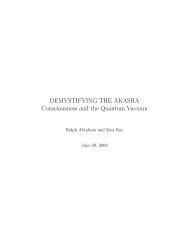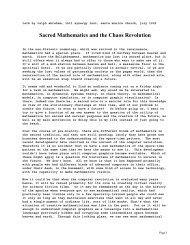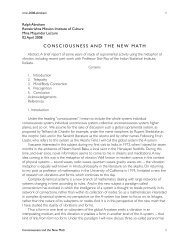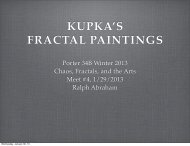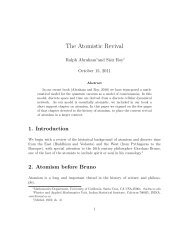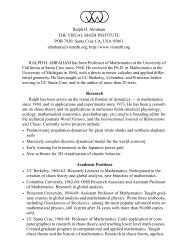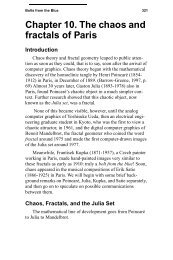BOLTS from the BLUE - Ralph Abraham
BOLTS from the BLUE - Ralph Abraham
BOLTS from the BLUE - Ralph Abraham
You also want an ePaper? Increase the reach of your titles
YUMPU automatically turns print PDFs into web optimized ePapers that Google loves.
Bolts <strong>from</strong> <strong>the</strong> Blue<br />
1<br />
INTRODUCTION<br />
This book is about <strong>the</strong> role of ma<strong>the</strong>matics in <strong>the</strong> evolution<br />
of culture, and <strong>the</strong> evolution of ma<strong>the</strong>matics itself. It aims to clarify<br />
<strong>the</strong> question: What is ma<strong>the</strong>matics, and who is a ma<strong>the</strong>matician? We<br />
believe that everyone has a native ma<strong>the</strong>matical talent, before it is<br />
tainted in school by math anxiety. In this book we give six examples<br />
of bolts <strong>from</strong> <strong>the</strong> blue, in which an artist and self-taught ma<strong>the</strong>matician<br />
brings forth an important new ma<strong>the</strong>matical idea in an intuitive<br />
revelation, an innovation that triggers a major transformation within<br />
ma<strong>the</strong>matics, and in cultural history as well. The book is organized<br />
around three main <strong>the</strong>mes:<br />
• Dynamical historiography, that is, world cultural history<br />
regarded as a complex dynamical system, a network of cultural<br />
ecologies, a history evolving through epochs (plateaus) segmented<br />
by bifurcations (generalized paradigm shifts). Chaos <strong>the</strong>ory — comprising<br />
<strong>the</strong> new computer-based ma<strong>the</strong>matical <strong>the</strong>ories of nonlinear<br />
dynamics, fractals, chaos, bifurcations, complexity, neural networks,<br />
and so on — provides a new way of looking at any complex dynamical<br />
system. The first of our three main <strong>the</strong>mes is based on this new<br />
way of looking at one of <strong>the</strong> largest complex systems of all: world<br />
cultural history 1<br />
• Ma<strong>the</strong>matical mentality, that is, <strong>the</strong> dominant style of ma<strong>the</strong>matical<br />
cognition exhibited by individuals in a cultural ecology.<br />
We will describe five mentalities <strong>from</strong> <strong>the</strong> viewpoint of dynamical<br />
historiography, cultural ecology, and bifurcation <strong>the</strong>ory. This <strong>the</strong>me<br />
is a math-centric kind of cognitive psychology, in which we characterize<br />
an entire cultural ecology by its ma<strong>the</strong>matical style. This is<br />
analogous to art history being divided into Ancient, Medieval, and<br />
Modern, for example.<br />
• Bolts <strong>from</strong> <strong>the</strong> blue, that is, <strong>the</strong> reception of a new ma<strong>the</strong>matical<br />
strategy by an artist or intellectual, as if by telepathy <strong>from</strong><br />
1 See (<strong>Abraham</strong>, 1994) for an early account of this view. One of <strong>the</strong> first<br />
historians to adopt <strong>the</strong> chaos <strong>the</strong>oretic view is William Irwin Thompson.




